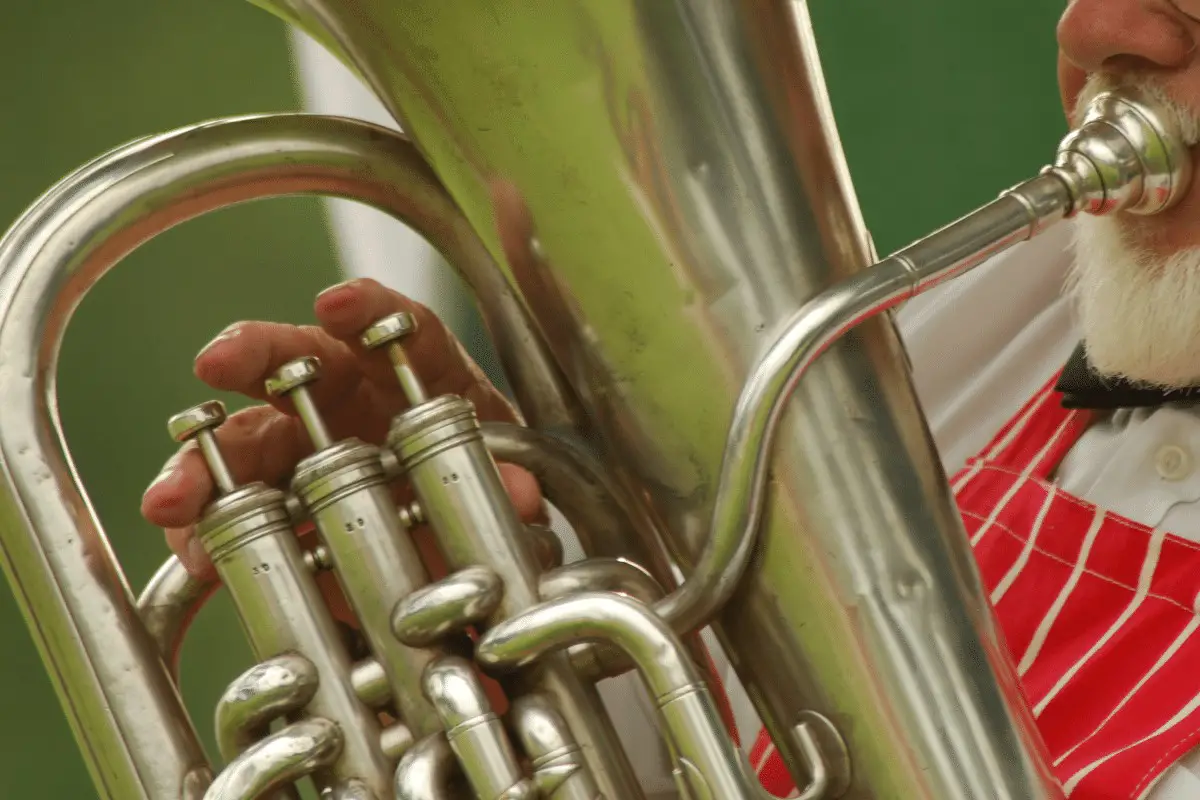Bands and live music are becoming more popular as of late.
I think this is due to our wanting to enjoy more types of live music after being shut down and stuck at home due to the COVID-19 pandemic.
So a lot more people are seeing new brass instruments and wondering just what some of them are, including when you see a small tuba.
The small tuba you see is most likely called a euphonium, or it’s the instrument’s cousin called a baritone. Euphonium and baritones both serve the same role; they play around an octave higher than the tuba (the same range as the trombone) and use valves to change their pitches.
The small tuba you see may be a couple of other things, depending on what exactly it is.
Read ahead to hear the options and help decide what type of small tuba you have in question.
Hey! If you like tuba stuff, check out my Instagram!
Table of Contents
Figuring Out What The Small Tuba Is You See
In this section, I’ll guide you through a series of questions and qualities to help you.
Rather than go into the details on the hyper-specifics, let’s get our question answered.
So you’re looking at what you think is a tuba, but it seems smaller than normal.
Ask yourself these questions to help determine its type:
1. Are you at a high school, middle school, or community band-related concert?
If not, look ahead for question #5.
If you are, then you need to ask yourself the next questions:
2. Is the bell (opening at the top) of the player’s instrument pointed slightly to their right?
If so, it’s either a euphonium or a baritone.
If it’s straight up or to the left, it’s a type of tuba.
If you’re at any of the events from question #1, it’s what they call a 3/4 tuba. This tuba is smaller than the standard, so it’ll be easier to produce enough air to make a good sound.
This tuba is also a BBb tuba or contrabass tuba.
This means when no valves are pressed, its fundamental pitch is the Bb three octaves below middle C.
3. Do the pipes or tubes stay small until the end (where the bell flares out)? Is the sound “bright” to you?
If so, you see the baritone.
Baritones are cylindrical bore instruments; the tubes stay about the same size until the end of the horn.
This is what gives the horn a brighter sound.
People often call a euphonium a baritone and use it interchangeably.
I’ve even heard band directors call is the wrong type often.
While they do play in the same range, the sound quality is different.
If you’re in America (or anywhere other than the U.K.), it’s likely a euphonium.
4. Do the pipes or tubes get gradually larger until the end? Is the sound “dark” and complex to you?
If so, you have a euphonium.
The euphonium is essentially a mini-tuba (to the point it’s also called a tenor tuba).
It’s designed in the same way as a tuba, and it plays an octave higher (in the same range as the trombone).
The euphonium is present in all types of groups, including British brass bands where you usually see the baritone, too, so the group type isn’t likely to help you with this.
When the tubes get gradually larger, it’s called a conical bore.
This is what gives a darker sound like the tuba, cornet, and french horn.
5. Are you seeing an advanced group? Such as…
The type of group will help you determine why the tuba you see is small.
In the chart below, we’ll cover the small tubas you’ll see in each type of advanced group.
You’ll notice we introduce two new types of tubas (Eb and F tubas). These are specialty tubas that play halfway between the standard tuba range and the euphonium/baritone.
| Group | Small Tuba Options |
|---|---|
| British-style brass band* | Euphonium, Baritone horn, Eb tuba, F tuba |
| Salvation Army Band | Baritone, Eb tuba (less likely) |
| College concert band | Euphonium |
| All tuba group | Euphonium, F tuba (less likely) |
| Orchestra | Euphonium (rarely) |
| Brass Quintet (5 people) | F tuba |
| German Band / Oktoberfest | Euphonium |
Remember, this is only the most likely option. There are always exceptions.
Use the other questions from above to help you determine tuba vs. euphonium/baritone.
But these groups will not use the smaller 3/4 BBb tuba like high school or middle school groups usually will.
Best Way To Determine Small Tuba’s Name
There is one fool-proof way tot determine a tuba’s type or name.
Ask the player.
Speaking as a tuba player for over *cough cough* 20 years, I love to talk about my horn and the types of tubas.
Further Reading: 19 types of tubas and what they are
Commonly Asked Questions
What’s a double-bell euphonium?
This is a weird instrument, but kind of cool. It’s basically a baritone (cylindrical and bright) and euphonium (conical and dark) fused together. With one button push you can switch between each bell and change the quality of sound.
What about marching bands?
Marching bands don’t use the modern tuba in many cases.
If you see a small tuba there, it’ll either be a marching baritone (like a giant trumpet) or a convertible euphonium where the bell faces forward.
What kind of valves does the euphonium/baritone use?
Rotary valves or piston valves.
Do euphonium players prefer the true euphonium or baritone?
Most of the time in military bands, wind bands, school bands, and so on, they’ll never play a baritone, so the question is moot.
Other than this, it’s a matter of preference.

